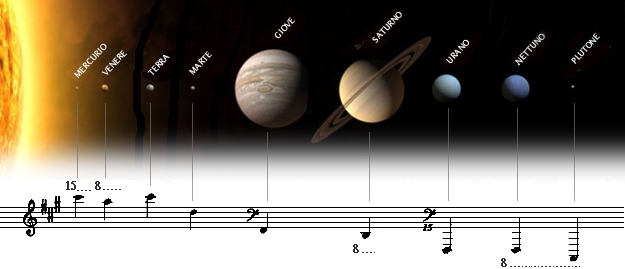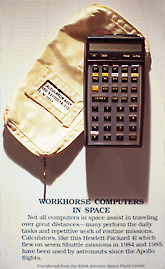|
|
 |
 |
|
 |
|
ALBA MUNDI, The sound of the Planets
|
The earth and each of the planets of the solar system revolving around the sun makes a musical note so low it cannot be heard by the human ear.
If we imagine a piano keyboard without limitation, the sound of the earth is a "C sharp" placed 33 octaves below middle C (about 4.7 meters left of the piano bench)
The song “Alba Mundi” is composed in the key of the earth, and the harmony of the track evolves by using the nine notes of the planets orbit frequency.
Mercury - the closest planet to the sun - plays a "C sharp" with its orbit. The orbit of Venus runs the note "A", and the sequence goes on with the Earth (C sharp ), Mars (D), Jupiter (F sharp), Saturn (D), Uranus (G sharp), Neptune (G sharp) and Pluto (C sharp). At the end of the piece, after the final crescendo you can listen to the "sound" of the solar system, accelerated by more than 68 billion times in order to be audible to the human ear.
The recording of the piece "Alba Mundi" was mastered by Alex Wharton (who has worked for Coldplay, Bjork, Gorillaz) at the Abbey Road studios in London, the historic recording studios where the Beatles and Pink Floyd albums were produced.
| "Alba Mundi" - video explanation |
|
|
|
|
"I've always found the idea of being able to hear the notes played by the planets with their rotation around the sun fascinating. These fluctuations are not perceptible to the human ear - due to their very low frequency and vacuum environment that does not allow the dissemination - but it's always musical notes, according to rigorous mathematical formulae.
Since the time of Kepler, many pieces on the planets have been written. Archimedes in ancient Greece associated the musical intervals with the "wandering stars". But where mathematics and astronomy were applied with their physical laws, musical aesthetics and beauty disappeared. So many authors (as in Gustav Holst's "Planets") preferred to describe the planets musically according to their mythological representation: Mars as the god of war, Venus the goddess of beauty, Jupiter as the father of the gods with his majesty, and so on.
What I still had not been able to listen to was a composition on the planets that is rooted on solid mathematical foundations, but was at the same time structured like a nice piece of music."
 The note played by the planets with their rotation around the sun, transposed up to 36 octaves
The note played by the planets with their rotation around the sun, transposed up to 36 octaves
|
"I composed "Alba Mundi" by creating the harmony of the nine "notes" made by the planets. At the end of the piece I wanted to insert the cold "sound" of the solar system, accelerated by speed so as to be audible to the human ear. The strange hissing sound, which remains highlighted at the end of the final crescendo is the sound of the solar system accelerated more than 68 billion times (36 octaves more acute) so as to be listenable. In practical terms, every second of sound we hear at the end of "Alba Mundi" corresponds to 2177 years of life in the solar system."
The keyboard depicted at the top of the Figure is a hypothetical keyboard of 12 octaves where the oscillation frequencies of the planets can be placed. In order to arrive at audible frequencies, we would roughly triple the extent of this keyboard (as shown in the bottom of the picture) and then finally move closer to a grand piano itself.
planet

|
orbital period

|
frequency (Hz)

|
key

|
octave

|
tune

|
cent

|
|
MERCURY
|
87,97 gg
|
1,3156842*10-07
|
C#
|
-27
|
up
|
+33 cent
|
|
VENUS
|
224,7 g
|
5,1509009*10-08
|
A
|
-29
|
up
|
+10 cent
|
|
EARTH
|
365,26 gg
|
3,168722*10-08
|
C#
|
-29
|
down
|
-31 cent
|
|
MARS
|
686,98 gg
|
1,684776*10-08
|
D
|
-30
|
down
|
-25 cent
|
|
JUPITER
|
4332,59 gg
|
2,6713984*10-09
|
F#
|
-33
|
down
|
-13 cent
|
|
SATURN
|
10759,52 gg
|
1,0757054*10-09
|
D
|
-34
|
up
|
+12 cent
|
|
URANUS
|
30684,4 gg
|
3,7719734*10-10
|
G#
|
-36
|
down
|
-2 cent
|
|
NEPTUNE
|
60195 gg
|
1,9227634*10-10
|
G#
|
-37
|
up
|
+32 cent
|
|
PLUTO
|
90475 gg
|
1,2792566*10-10
|
C#
|
-37
|
up
|
+26 cent
|
The second column shows the orbital period (in days) of the planet, the number of days used to take a trip around the sun.
The third column shows the exact frequency of rotation of each planet expressed in Hertz, and shown in an exponential notation because they are in the order of billionths of Hz.
The fourth column shows the note "played" by the planet with its orbital rotation.
The fifth column indicates the ocatve pitch of the planet (on the piano, the lowest octave is conventionally octave -1 while the higher notes on the keyboard are in the octave +6).
The sixth column indicates whether the pitch of the planet is sharp or flat compared to the note.
The seventh column gives an indication of the "false note" (a "cent" is a hundredth of a semitone).
The "merit" for the planet most in tune goes to the planet Uranus. The most "tone deaf" are in order Mercury, Neptune, and in third place, the Earth. The "pitch" or more properly the average pitch in which the solar system is tuned to is 441.27 Hz, which is only five hundredths of a semitone above our traditional “A” note conventionally fixed at 440 Hz (five hundredths of a semitone difference are perceptible only by a discrete "musical ear").
Details on computing systems
The notes of the planets are obtained by a mathematical calculation applied to the related periods of rotation around the sun, corresponding to the opposite of the rotation frequency. The principle is simple: a frequency oscillation (expressed in Hertz) and a precise musical note corresponds to each body with a periodical oscillation which is constant over time.
The mathematical formula for the calculation of the note is as follows:
where F is the frequency of the oscillation of the planet (in our case, for oscillation we mean the rotation around the sun), n(semit) is the musical interval in semitones starting from C1 (the first C starting from the left side on a piano keyboard, corresponding to the frequency 32.7031956626 Hz). The rotation frequency of the planet is obtained by the opposite of the period of rotation around the sun, calculated in seconds.

The notes played by the planets in order of distance from the sun, shown in a single octave..
To calculate precisely the notes corresponding to the orbit of each planet, we used a Hewlett Packard HP41cv programmable calculator, produced in the early 80s by Hewlett Packard. This model of pocket calculator has been used by astronauts on nine NASA missions in the Shuttle spacecraft because of its versatility and the computing power. In case of failure of the onboard computer, the computer was programmed to provide the parameters for re-entry maneuvers into the atmosphere.
The program for the HP41v calculator designed to calculate the notes played by the planets in the track "Alba Mundi".
|
|
01
02
03
04
05
06
07
08
09
10
11
12
13
14
15
16
17
18
|
LBL"ABAB
"GIORNI?
PROMPT
STO 01
FIX 4
86400
×
STO 02
440
×
LOG
12
×
2
LOG
/
CHS
57
|
19
20
21
22
23
24
25
26
27
28
29
30
31
32
33
34
35
37 |
+
STO 03
RCL 02
1/X
HZ
ARCL *
AVIEW
STOP
RCL 03
FIX 0
"KEY
ARCL X
AVIEW
STOP
12
/
INT
1
|
37
38
39
40
41
42
43
44
45
46
47
48
49
50
51
52
53
54 |
STOP
RCL 03
12
/
FRC
12
×
12
+
FIX 5
"NOTA
ARCL X
AVIEW
STOP
-
"OCT
ARCL X
AVIEW
|
 |
|
|
|
 |
 |
|
|